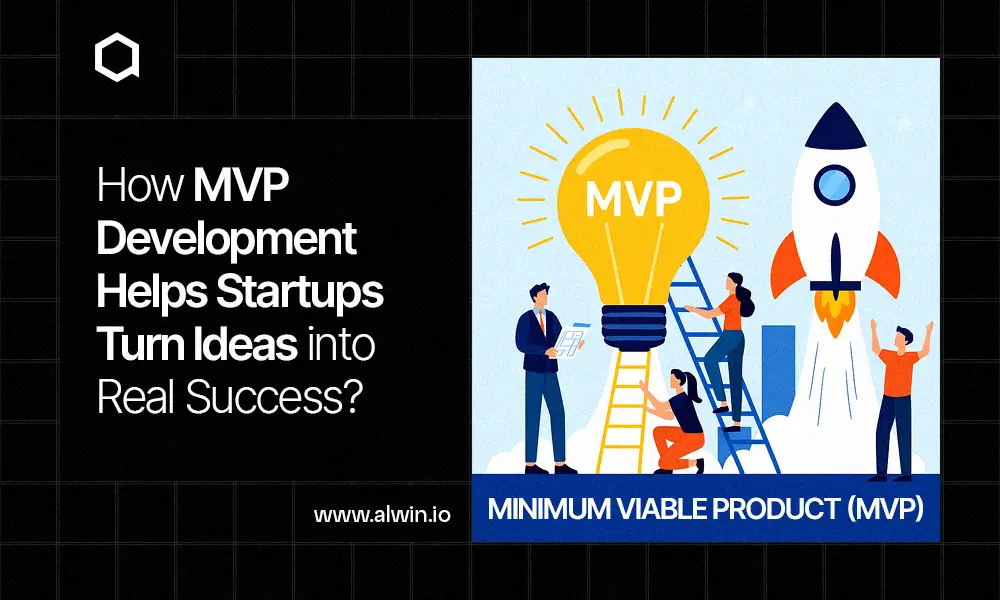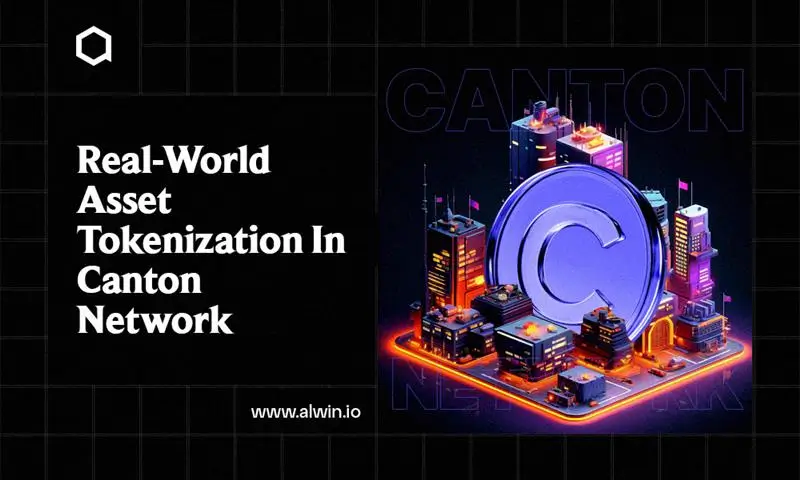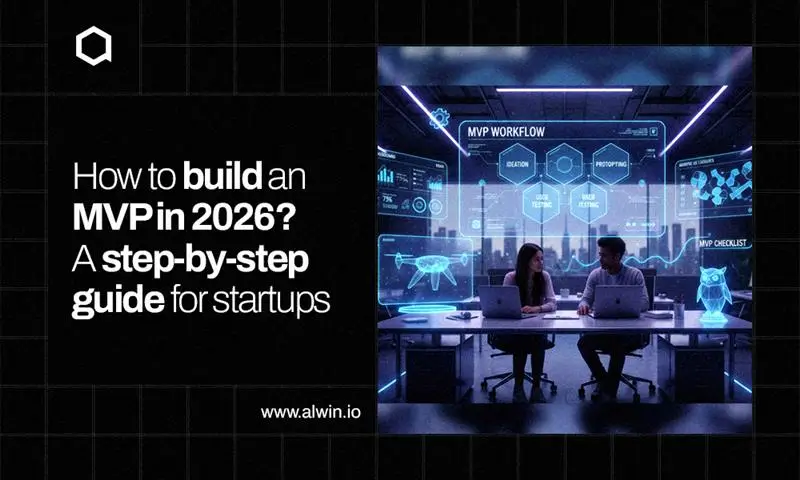We all want to launch a perfect product, but in reality, perfection before release is impossible. How can you know your product works if real users haven’t tried it yet? This is where the Minimum Viable Product (MVP) helps. For startups, an MVP is a simple version of your product with just enough features to test your idea with real users. It lets you learn what works, what doesn’t, and what people really need without spending too much time or money.
In this article, we’ll explain what an MVP is, why it’s important, and how to make one step by step. We’ll also talk about the cost of building an MVP. Whether you’re just starting or refining your product, understanding MVPs can save time, money, and effort.
What is an MVP?
An MVP (Minimum Viable Product) is the simplest version of your product that you can release. It includes only the key features that solve the main problem for users.
By starting with an MVP, you can:
Test your idea with real users
Learn quickly what works and what needs improvement
Save time and money before building the full product
Main Purpose of an MVP
The main goal of a Minimum Viable Product (MVP) is to test your idea with real users as quickly and cheaply as possible.
Instead of building a full product with every feature, an MVP focuses on the most important parts that solve the core problem. This way, you can:
- See if people actually want your product
- Learn what works and what doesn’t
- Save time, effort, and money before creating the full version
- Make improvements based on real feedback
In short, an MVP helps you validate your idea and reduce risk before investing heavily in development.
MVP vs Other Product Development Strategies
When creating a product, startups and companies often choose different strategies depending on their goals, resources, and market readiness. Let’s break down the key approaches:
Full-Featured Product (Traditional Approach)
A full-featured product is a complete version of your product built with all planned functionalities before launch. This approach focuses on delivering a polished, finished product to the market.
Advantages:
Polished and professional: The product feels complete and visually appealing, offering a strong first impression.
Comprehensive functionality: Users get access to all planned features, which can reduce complaints about missing features.
Clear market fit: Works well when the target audience’s needs and preferences are already well-understood.
Brand credibility: Launching a finished product can help establish trust and authority in a mature market.
Disadvantages:
Expensive: Developing every feature upfront requires significant investment in development, design, and testing.
Time-consuming: Long development cycles can delay the launch, allowing competitors to capture market share.
High risk: If users don’t like the product, the time, money, and effort invested are lost.
Limited flexibility: Once launched, it’s harder to adapt to real user feedback or changing market trends.
MVP (Minimum Viable Product)
An MVP is a basic version of a product with only the essential features needed to test the idea with real users. The goal is to validate assumptions, learn from feedback, and iterate before building a complete product.
Advantages:
Faster to launch: You can bring your product to market quickly and start testing user reactions.
Cost-effective: Focuses only on core features, reducing upfront development costs.
Real user feedback: Early adopters provide actionable insights, helping you refine the product.
Risk reduction: Validates whether the product idea works before committing extensive resources.
Flexible: Allows for continuous improvement based on actual usage.
Disadvantages:
Feels basic or incomplete: Users may perceive the product as underdeveloped.
Careful feature selection: Deciding which features to include is critical; missing essential features can give the wrong impression.
Potential limited branding impact: Early versions may not impress users or investors aesthetically.
Prototype
A prototype is an early, often non-functional version of a product used to demonstrate the idea, test design concepts, or validate usability. Unlike an MVP, it’s usually not intended for real users to solve problems.
Advantages:
Communicates vision: Helps show investors, stakeholders, or team members how the product will work.
Quick and inexpensive: Can be developed rapidly without full coding or integration.
Tests usability and design: Useful for experimenting with layouts, workflows, and interactions.
Low risk: Since it’s not fully functional, changes are easy and inexpensive.
Disadvantages:
Not for real use: Users cannot use the product to solve real problems.
Limited market validation: Feedback is mostly about impressions, not actual user behavior.
Cannot generate revenue: Prototypes are typically just for testing and pitching.
Why MVP Development Is Important For Startups?
Starting a business is exciting, but turning an idea into a real product takes the right plan. MVP Development helps startups bring their vision to life faster and smarter. It allows you to test your idea, reduce risks, and grow with confidence before investing big.
Testing Business Ideas
Every startup begins with an idea, but not every idea fits the market. MVP Development helps you launch a simple version of your product to see if people truly need it. This process gives you clear insights and helps you build what users actually want.
Saving Time and Money
Building everything at once can waste time and resources. MVP development focuses only on the main features that solve real problems. This smart approach helps startups move quickly, spend wisely, and reach the market faster.
Getting User Feedback
User feedback is the key to improvement and long-term success. By testing an MVP, startups can collect honest reactions, understand what works, and make better decisions. Listening to users helps you shape a stronger and more user-friendly product.
Focusing on Key Features
The best products start small but deliver strong value. With MVP Development, you focus only on what truly matters to your customers. This keeps your product simple, useful, and easy to upgrade as your business grows.
Learning and Improving
Each MVP launch is a step toward building something great. It helps you learn from real users, improve faster, and adjust to market needs. Partnering with an experienced MVP development company gives your startup expert support, guidance, and a smoother path to success.
How to Build an MVP for Your Startup: A Detailed Guide
Building a Minimum Viable Product (MVP) is a smart strategy for startups to validate their ideas, gather user feedback, and reduce risk before investing heavily in full product development. Below is a step-by-step approach to creating a successful MVP.
1. Identify the Core Problem
To start building an MVP, the first step is to research your target market and understand the main pain points your users face. Spend time studying their challenges, preferences, and what solutions they currently use. Instead of trying to fix every issue at once, focus on one key problem that has the most impact. This helps you create a strong foundation for your product. Ask yourself, “What is the one problem my product can solve better than anyone else?” — this question keeps your vision focused and ensures that your MVP delivers real value to users from the very beginning.
Example:
Uber started with the core problem: “Users need reliable and convenient transportation on-demand.”
Other features like ratings, route optimization, and ride-sharing were added later.
2. Define Your Target Audience
Understanding who will use your product is important for MVP success. The next step is to identify your target audience, especially the early adopters — the people most likely to try and support your product first. These users are open to new ideas and can provide valuable feedback. To understand them better, create user personas that describe their habits, age group, goals, and frustrations. This helps you see your product from their point of view. Think carefully about their expectations and how your solution can make their lives easier or better. By focusing on the right audience early on, you ensure your MVP is designed for the people who will truly benefit from it and help shape its growth.
3. Outline and Prioritize Features
When planning your MVP, start by listing all the possible features your product could have. Once you have the full list, categorize each feature based on its importance. Identify the must-have features — the core functions that solve the main problem and deliver direct value to users. Then, separate the nice-to-have features, which can add extra benefits but are not essential for the first launch. Focus only on the must-have features for your MVP. This approach helps you stay efficient, avoid unnecessary complexity, and make your first version truly useful for your target audience.
Example
Instagram’s MVP focused on photo sharing, simple filters, and social interactions. Other features like stories, reels, and messaging were added after validating user interest.
4. Create a Prototype (Optional but Recommended)
Before starting full development, creating a prototype is a smart way to visualize your idea and test its functionality. Begin by designing wireframes or mockups of your product using tools like Figma, Adobe XD, or InVision. These designs help you outline the layout and flow of your product before any coding begins. Once the prototype is ready, test the user flow to see if it’s easy and logical to navigate. Then, share it with stakeholders or a small group of users to collect early feedback. This step helps you spot issues, make improvements, and move into development with a clearer vision.
Benefits
Saves development time and cost.
Helps identify usability issues early.
Supports fundraising or investor pitches.
5. Develop the MVP
An MVP is a working version of your product that focuses only on the most important parts. Start by building the essential features needed to solve the main problem for your users. Keep the product simple, easy to use, and dependable so early users can get real value from it. Follow agile development methods to make quick updates and improvements based on feedback. The goal here is not perfection, but learning fast and proving that your idea works in the real world.
6. Launch to Early Users
Once your MVP is ready, launch it to a small and focused group of early users who match your target audience. These users are the best source of honest feedback and real-world insights. Gather their opinions through surveys, interviews, analytics, and direct observation to understand how they use the product and what challenges they face. Pay close attention to their behavior — which features they like, what confuses them, and where they struggle. This early testing phase helps you learn what works, what needs improvement, and how to make your product better before a wider release.
Example:
Dropbox started with a simple video MVP explaining file syncing to gauge user interest before developing the full platform.
7. Measure Key Metrics
After launching your MVP, the next important step is to measure its performance using the right metrics. Tracking key data helps you understand how users interact with your product, whether it’s meeting their needs, and where improvements are needed.
User engagement: How often users interact with your product.
Retention rate: How many users return over time.
Conversion rate: How many users take desired actions (sign-ups, purchases).
Feedback & satisfaction: User opinions on features, usability, and value.
8. Iterate Based on Feedback
An MVP is not a one-time release it’s a product that keeps evolving based on what you learn from users. After collecting feedback and analyzing metrics, take time to identify the main pain points and areas that need improvement. Look for patterns in what users like, dislike, or find confusing. Then, decide which features should be improved, added, or removed to make the product more effective. Use this information to refine your MVP in small, steady updates instead of big, risky changes. Continue testing each new version with users to confirm that the updates are moving your product in the right direction. This process of iterating and improving helps your MVP grow into a product that truly meets user needs and fits the market.
Benefits
Reduces risk by ensuring changes are guided by real data.
Builds a product that truly meets user needs.
9. Plan for Scaling
Once your MVP has proven the concept and shown that users find value in your product, it’s time to plan for scaling. Start by strengthening your infrastructure to handle increased traffic and a growing number of users without performance issues. Next, consider adding secondary features that provide additional benefits and make the product more useful to a wider audience. At the same time, ensure that security, data management, and compliance processes are in place to protect users and meet regulatory requirements. Proper planning for scaling allows your product to grow smoothly, reach more users, and transition from a simple MVP into a fully-featured, robust solution.
Example:
Airbnb’s MVP started as a simple booking platform for air mattresses. Over time, they added payment processing, user reviews, property management, and mobile apps as demand grew.
Building an MVP allows startups to test assumptions, save resources, and reduce risk. By focusing on core functionality, learning from real users, and improving strategically, your startup can grow with confidence and build a product that truly meets market needs.
Early Products That Built Billion-Dollar Companies
AdWords Express
Google launched AdWords Express to make online advertising simple for small businesses. It helped local owners reach nearby customers quickly and easily. This early idea became the foundation for Google’s powerful global advertising platform that supports millions of brands today.
Airbnb
Airbnb began when its founders offered air mattresses in their apartment to travelers looking for a place to stay. That small step created a new way for people to travel and connect. From a simple website, it grew into a trusted community serving millions of guests and hosts worldwide.
Amazon
Amazon started in a small garage as an online bookstore with a few titles. The focus was on customer satisfaction, fast delivery, and fair prices. This early approach became the key to building one of the largest e-commerce and technology companies in the world.
Buffer
Buffer’s first version was a simple tool that allowed users to schedule tweets ahead of time. It helped people stay active online without constant effort. Over time, it evolved into a complete social media management platform used by individuals and global brands.
Uber
Uber began as an app called “UberCab,” allowing users to book car rides with one tap on their phones. It offered an easy and convenient travel experience that people instantly loved. That small concept transformed urban transportation and became a worldwide ride-sharing revolution.
These billion-dollar companies show that success grows from small beginnings. Each one started with a focused idea that met a real need. With passion, user feedback, and steady improvement, even the simplest product can turn into something remarkable.
MVP Development Cost For Startups
The cost of developing a Minimum Viable Product (MVP) varies widely depending on several factors, including the complexity of the product, the number of features, the technology used, and whether you hire freelancers, an in-house team, or a development agency. Understanding these costs helps startups plan budgets effectively and avoid overspending.
Simple MVP: $5,000 – $15,000
Basic features, minimal design, small user base, often suitable for no-code or simple app solutions.
Moderate MVP: $15,000 – $50,000
Core functionality with some advanced features, custom UI, and testing included.
Complex MVP: $50,000+
Multiple features, integrations, high-quality design, scalable architecture, suitable for enterprise-level startups.
Challenges Of Building A Startup MVP
Common MVP Mistakes
Many startups make the error of adding too many features at once, which slows down the launch and confuses users. Skipping user testing or ignoring feedback can result in a product that does not solve real problems. Avoiding these mistakes helps create a focused MVP that provides real value quickly.
Balancing MVP and Future Goals
Startups often struggle to produce a simple MVP while planning for future growth. Focusing on key features first while keeping a roadmap for updates helps maintain clarity and direction. Balancing immediate value with long-term vision allows the MVP to grow into a scalable, successful product.
Why Startups Choose Wealwin, The MVP Development Company?
Startups choose WeAlwin, the MVP development company, because it turns ideas into simple, practical products that users love. With a clear focus on building lean, high-quality MVPs, WeAlwin helps startups test concepts, gather user feedback, and reduce risks while creating a strong base for growth.
Partnering with WeAlwin, the MVP development company, gives startups guidance at every stage, from planning to launch. Their approach focuses on quality, simplicity, and real market needs, helping your product reach users faster and succeed.
Get in touch with WeAlwin today to bring your startup idea to life with a market-ready MVP!



